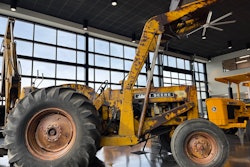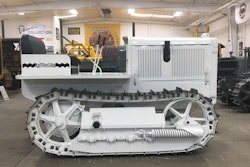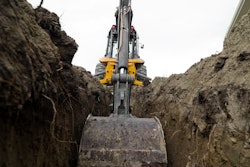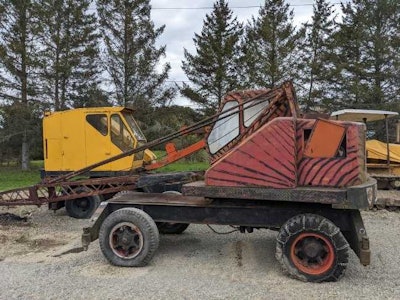
Garret Wilson has collected and restored antique construction equipment since he was about 20 years old. And on May 1, he found his “holy grail.”
He has a particular love of vintage Schield Bantam cranes, cable-operated machines eventually replaced by the hydraulic excavator.
Ten years ago, he acquired his first, a 1961 Bantam T-350 truck-mounted crane.
Later at an antique equipment show, he found another that he ended up buying, a 1965 Bantam C-350 crawler crane.
Then on May 1, he found what will likely be his new favorite, a Bantam CR-35 wagon crane. The mid-1950s era piece was the precursor to the wheeled excavator.
It also means he has acquired all of Bantam’s cable crane versions: truck-mounted, crawler and wagon.
“I don't know if anybody has all three of them,” he says. “I know guys who have one or the other, two or whatever, but nobody that I know of has all three.”
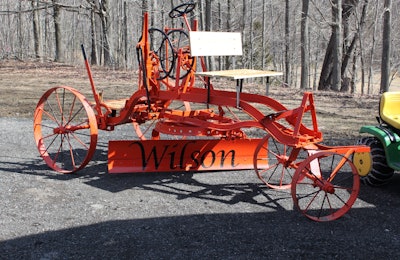 This Galion Standard Premier horse-drawn road grader was Garret Wilson's first antique machine. He bought it when he was about 20 years old and used it to grade his driveway. He estimates it was built in the early 1900s. It was designed to be pulled by four horses or two oxen. It's now parked at the end of his driveway. He restored it and added the "Wilson" on the blade.Garret Wilson
This Galion Standard Premier horse-drawn road grader was Garret Wilson's first antique machine. He bought it when he was about 20 years old and used it to grade his driveway. He estimates it was built in the early 1900s. It was designed to be pulled by four horses or two oxen. It's now parked at the end of his driveway. He restored it and added the "Wilson" on the blade.Garret Wilson
A scholar and an operator
Wilson, now 37, spent much of his youth in Beaver Dams, New York, studying about construction equipment and running it.
“I've worked in construction since I was 12 years old,” he says. “I used to skip school to go to work.”
If he wasn’t on the construction site, you could find him with his nose buried in a book.
“When I was a kid, I found a lot of solace in reading the encyclopedia. I would just read the Encyclopedia Britannica,” he says. “It was the weirdest infatuation, but I had to know how everything worked. And I found operator's manuals and books and all kinds of stuff about equipment.”
He especially liked learning about the cable-operated machines. He would sit quietly with the old-timers on the construction sites, absorbing their knowledge.
“I grew up around the old guys. I listened to them talk,” he says. “… They would talk about this stuff and how everything worked.”
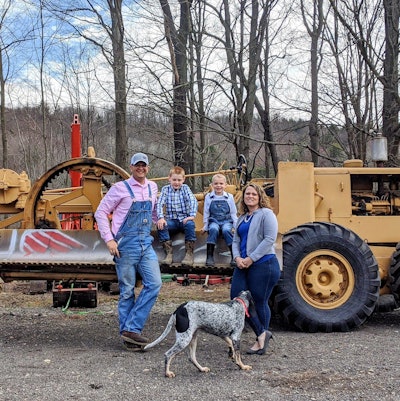 Garret Wilson and family with antique motor grader.Garret Wilson
Garret Wilson and family with antique motor grader.Garret Wilson
His first Bantam
In 1961, his neighbor’s father drove a 1952 REO M35 military surplus cargo truck from New York to the Schield Bantam Company factory in Waverly, Iowa.
“He stayed out there for like a week,” Wilson says. “He stayed in a hotel, and they gave him a tour of the factory and stuff. He got to watch them install the actual crane onto the truck and the cabin chassis.”
Schield Bantam built truck-mounted shovel cranes starting in 1942. The company was bought by Koehring in 1963, and the name transitioned to Koehring-Bantam. It later was acquired by Terex in 1987.
At one point Schield Bantam was the largest manufacturer of truck-mounted cranes in the world. The company also built crawler and wheeled versions on self-propelled carriers. The attachments, such as backhoe, shovel and grapple, were interchangeable among the machines. Many of the cranes were mounted to military surplus vehicles, including half-track and deuce-and-a-half trucks.
R.L. Callahan Inc., a contractor in Wilson’s hometown, used the newly acquired Bantam T-350, mounted to the 2.5-ton 6x6 truck, for cleaning out debris that would block waterways in the area. The 11-ton-capacity crane was equipped with a grapple and would be used to reach over the bridge abutments to pull out trees and other debris and trash for the highway department.
Out of high school, Wilson went to work for Callahan for four years as a laborer and later a full-time operator.
“They had a bunch of cranes at the time, and this one just sat,” he recalls. “They didn't do anything with it. It was always in the yard. It was always kept up and cleaned up.”
Wilson went on to work as an operator on heavy highway jobs and now owns his own residential company, GP Wilson Grading & Excavation.
But the Bantam truck-mounted crane stayed on his mind.
Ten years ago, he decided to buy it.
As fast as hydraulics?
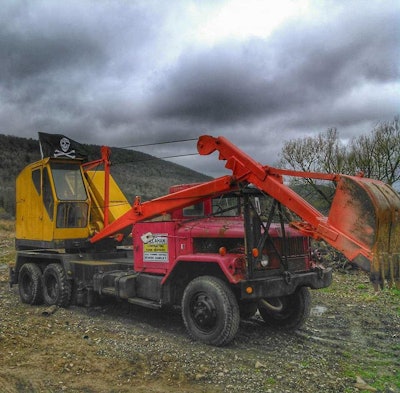 Garret Wilson's 1961 Bantam T-350 mounted to a 1952 "Deuce and a Half."Garret Wilson
Garret Wilson's 1961 Bantam T-350 mounted to a 1952 "Deuce and a Half."Garret Wilson
“It intrigued me because I wanted to see what was so hard about it,” he says of the cable-operated machines. “And I also respect the history of this stuff, stuff that built the world that we live in today. It took a much greater skill and more knowledge and talent.”
So he put a backhoe on his newly bought Bantam and climbed inside.
“A lot of people have a hard time believing it, but there really wasn't much of a struggle for me,” he says. “I did so much studying that I knew what I had to do.”
He understood how all the clutches and brakes work and how the various cables interact.
“When you’ve got to pull clutch levers and run brakes and all that stuff to make these backhoes and shovels and cranes work, it's not like all this modern stuff, where when you let off the controls, everything just kind of stops,” he says. “With this old stuff, if you let off the controls, the stuff falls out of the sky. You have to be aware of how everything works and the coordination that it takes to make it work in a fluid motion.”
Another thing that might be difficult for modern operators to believe is that he can dig with the cable backhoe as fast or faster than with a hydraulic excavator when just straight digging.
“I'll go to a show ... and people stand around and watch in amazement, because they just assume that it's old and slow,” he says. “And it's actually not. It's the exact opposite in the right hands. But the problem is, not everybody's … cut out for that.”
Don't believe it can run fast? Check out this video Wilson submitted of himself at the controls:
Hitting the trifecta
Wilson was at the Pageant of Steam antique equipment show in Canandaigua, New York, in 2014 when he saw a 1965 Bantam C-350 crawler crane. He let the owner know if he ever wanted to sell it to call him.
A couple of years later, he called.
The 8-ton-capacity crawler crane has two-speed independent travel and can dig down to 18 feet 10 inches. It had been used in a rock quarry in Syracuse but not as a production machine.
 Garret Wilson at the controls of his 1965 Bantam C-350 crawler crane before it was restored.Garret Wilson
Garret Wilson at the controls of his 1965 Bantam C-350 crawler crane before it was restored.Garret Wilson
Then this year, he found the third type of Bantam friction machine on social media: the CR-35 Bantam wagon crane.
“The wagon crane was the original wheeled excavator,” he says, “because you could put the cable backhoe on it.”
It sits on a self-propelled, two-axle carrier with the Bantam crane upper section on top. The owner had inherited it with some property and wanted to make sure it went to a good home.
Wilson grew up with Drott and Case 1085 wheeled excavators. He also has an original Drott 40 on rubber tires.
He hasn’t been able to check the wagon crane’s serial number yet to determine its exact model date, but he estimates it’s from the mid-1950s. Schield Bantam began producing the CR-35 in 1953 as its first self-propelled crane.
“That’s going to be my favorite one because wheeled excavators have always been my bread and butter,” he said just four days before traveling to pick it up. “I grew up on them.”
He plans to equip it with a backhoe attachment he already has after he gets it fixed up and running. To him, it represents the triple crown of his collection.
“This Bantam CR-35 wagon crane is like my holy grail.”
Check out more photos of his trio of Bantam cranes below:
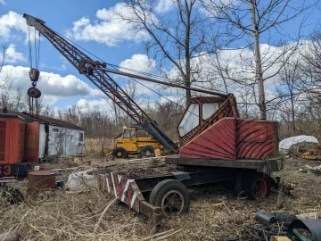 Garret Wilson's mid-1950s-era CR-35 Bantam wagon craneGarret Wilson
Garret Wilson's mid-1950s-era CR-35 Bantam wagon craneGarret Wilson
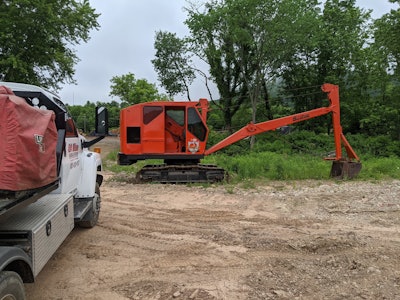 Restored 1965 C-350 Bantam crawler craneGarret Wilson
Restored 1965 C-350 Bantam crawler craneGarret Wilson
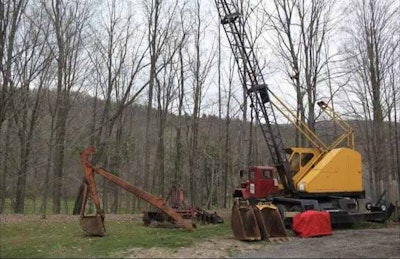 1961 Bantam T-350 truck-mounted-craneGarret Wilson
1961 Bantam T-350 truck-mounted-craneGarret Wilson



